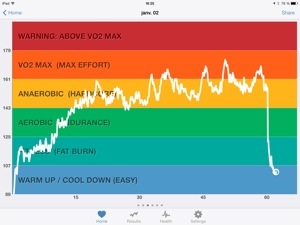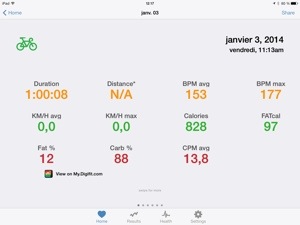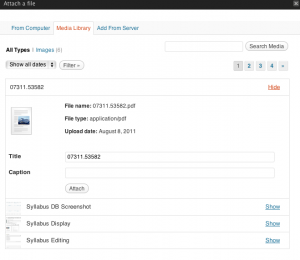For my Happiness Anniversary, this year, I got myself a brand new job.
Ok, it was two days late and a job isn’t really a gift. But it’s the thought that counts.
We’ll see how things go, but the position (Learning Technology Advisor) is right in line with things I already enjoy doing. Such as enabling technological appropriation in learning contexts. And holding thoughtful group discussions on interesting issues. And trying out new tools. And discussing learning objects and learning objectives. All things I’d probably do, regardless of my employment status.
So the work itself is likely to be very satisfying.
It’s been a while since I’ve had a fulltime dayjob. Years. Not that I haven’t been employed fulltime during that period. I did cumulate quite a few hours of work, most years. But they were part of different jobs, contracts, contexts. Which means that very significant a part of my “bandwidth” had to do with professional development. It also meant that my status tended to fluctuate. Teaching part-time was a large part of it, but a major distinction between part-time workers and fulltime ones relates to identity, status, recognition. For instance, sharing an office with a few colleagues is quite different from having your own.
I start my new job Tuesday, so I’ll know more by then (such as the office situation). But I’m already getting different interactions with people, such as this one teacher who says that we now have good reasons to be even better friends.
What’s funny is that the onset of my 2008 Happiness Phase coincided with my shift to freelancing. Had been doing several different things before that, mostly revolving around teaching and learning. But, from that point on, I allowed myself to take on contracts as a freelancer. I was no longer a Ph.D. candidate trying to squeeze in some work opportunity in view of an academic job. I was in control of my professional life, despite all the difficulties associated with freelancing.
It was a nice run. Ebbs and flows. Had the opportunity to try out many different things, sometimes within the same period of time. Landed a part-time position at a startup/community organization where the fit wasn’t great. Struggled to find a balance between acting as my own self and looking for new opportunities at every occasion. Had slow periods which made me question things. Coped with health issues in ways which would have been impossible while working fulltime. Invested time and money in all sorts of things to improve my life as a self-employed individual…
Overall, I learnt a lot. Much of it will be useful in fulltime work.
Though the job is fulltime, it’s based on a renewable contract. When, during the job interview, the HR advisor asked me for my thoughts on this situation, my whole freelance experience was behind me. No, it’s not an issue. I’ll manage even if it’s not renewed. But I’m starting a new life.
Something else about this new life connects to 2008. It’s in a Cegep.
Cegeps are Quebec public colleges for both vocational and pre-university education. I care deeply enough about the Cegep system to defend it. More than once. It’s occasionally under attack by politicians who try to stir things up. But it’s a part of post-secondary education in Quebec which makes it unique. Having taught in diverse places, I find that it makes a significant improvement in university life here. It also enables the kinds of training and learning that people really need, as “adulteens” (very young adults who are also “teen-aged”). In the past week, even before settling down in my new position, I got to see some impressive things happening in Cegeps. I sincerely think that cegeps are an example to follow, not an anomaly. Similar systems exist elsewhere (from “gymnasium” and “international baccalaureate” to “prep schools” and “community colleges”). But Quebec’s Cegep network is its own very specific thing, fully adapted to its own cultural and social context.
Surely, I’ll have a lot more to say about Cegeps as I work in one.
The connection to 2008 is much more personal. At the time, I was going through a difficult transition in my life. Questioning all sorts of things. Growing dissatisfied with the model for university careers (especially tenure-track professorships and what they entail). Thinking of “what I could do with my life”…
…when it suddenly hit me: I could work in a Cegep.
Can still remember the overwhelming feeling of comfort I experienced when that thought hit me. It was so obvious! So fitting! Sure, there’d be some difficulties, but nothing impossible. I was ready, then, to embark in a Cegep career.
It’s not what happened, right away. I came back to Quebec from Texas and applied to a few things in Cegeps. Was getting other contracts, including teaching contracts at Concordia (where I started teaching in 2006). Never abandoned the idea of working in a Cegep but “life had other plans”, at the time.
I did do several things which got me closer to the Cegep system. Including participations in every MoodleDay event at Dawson. And workshops with Cegep institutions. I even participated in a living lab on educational innovation with the very organization which just hired me (lab summary in French). Without really noticing it, I was preparing myself to join the Cegep World.
One obvious possibility was to add Cegep courses to my part-time teaching load or eventually becoming fulltime as a Cegep teacher. Cegep teaching has clear advantages over university teaching. Simply put, Cegep teachers are allowed to care about learning. University professors who care about pedagogical issues bump into lots of hurdles. Since I care a whole lot about teaching (and I can still do actual research without a tenured position), it sounded like the right place for me. Friends and acquaintances who work in Cegeps kept telling me things which made the fit even more obvious. Though grades do matter in Cegeps, the obsession with grades is much less of an issue in Cegeps than in universities. I care enough about this that I co-organized a public conversation on grades, back in November 2013. Of course, the Cegep population is quite different (and often younger) than the university population. Having taught in the US where people enter university or college directly from high school, I didn’t think it’d be an issue.
But teaching Cegep students directly wasn’t the only option. Having accumulated some expertise on post-secondary learning through 15 years of teaching experience, I was starting to think about being a learning advisor of some sort. This is finally happening, officially.
I’ve often acted as an informal advisor for people. Even during my M.Sc., I would discuss a Ph.D. student’s research in pretty much the way an advisor would. Not the advisor who focuses on logistics and rules and citation impact. But the person who challenges you to rethink a research question or brings you to think of your whole project in a completely new way. Since then, I’ve done the same thing numerous times without ever having an official title to go with it. I’d occasionally get a bit of (informal) credit for it, but I wasn’t aiming for that. I just enjoy helping people in this way.
I also became something of a mentor to some people. For instance, in view of a pilot project at Concordia, I was able to mentor two teaching assistants who were holding classes in parallel with me. The mentoring included tips and tricks about classroom management along with deeper things on the meaning of university learning. It was still a limited scope, but it was in line with things I wanted to do.
What was even more fitting, given my new position, is that I became the “go-to person” for several things having to do with technology in learning and teaching. This all started in 2007 when, through the Spirit of Inquiry conference, I started collaborating with Concordia’s Centre for Teaching and Learning Services. Created workshops, did screencasts, experimented with some solutions, answered informal questions… Without being employed directly by CTLS, I think it’s fair to say (as several people have been saying) that I was playing a key role in terms of learning technology at Concordia.
There’s a pattern, here. From diverse activities as a freelancer, I now get to merge things to be Learning Technology Advisor at Vitrine technologie-éducation.
Good times!









